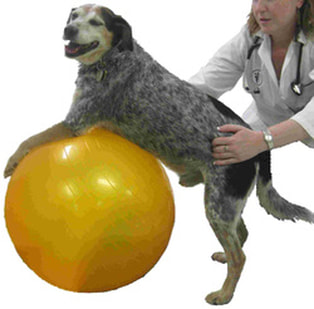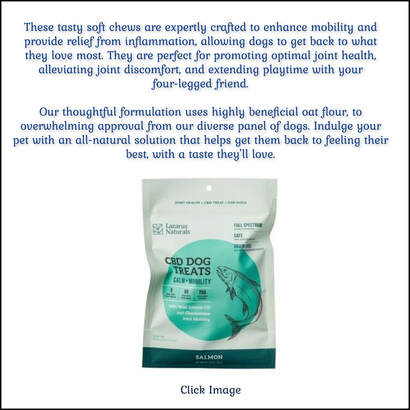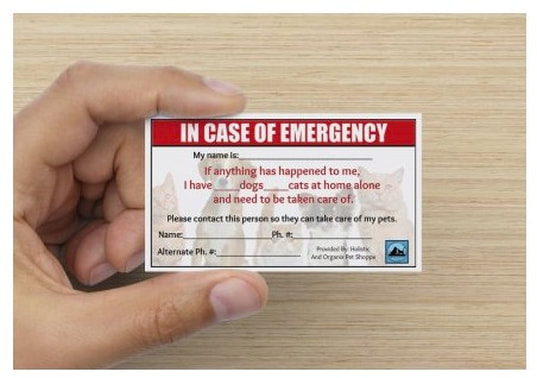|
By CanineRehabArthritis.com
Rehabilitation for Canine Total Hip Replacement During your discharge consultation after your dog's total hip replacement surgery, you will receive a packet of information with detailed home care instructions for your pet. Those instructions will include step by step directions that include appropriate dosages and frequency of giving medication, icing sequence, massage techniques and how to perform gentle range of motion exercises during the first 1-2 weeks following surgery. Additionally, you will receive information on initial activity restrictions for your pet. The purpose of these instructions is to minimize the swelling and stiffness in the joint that follows a surgical procedure. Furthermore, during the first few days after an operation, the surgeon wants to limit the pet’s activities in order to allow for healing of the tissue. During that time frame, your pet may experience swelling and bruising at the joint, hesitation to put weight on their involved leg, and difficulties with mobility like getting up from the floor. You can help your pet get around by using a large sling wrapped under their belly and assisting them with walking, pottying and getting up off the floor. After the first few days, your pet’s joint swelling, stiffness and soreness should be steadily improving. You will want to continue to limit the dog’s activities to controlled leash walking for about 5-10 minutes, 2-3 times a day. At the two week mark, your pet can begin post total hip replacement rehabilitation, where they will receive an in-depth examination to look at the strength, flexibility and soreness level of the surgical leg as well as the whole body. At your initial evaluation at Canine Rehabilitation and Arthritis Center, your therapist will develop an individualized therapeutic program designed to meet the dog’s specific needs. Your pet’s therapy can include massage and stretching for the stiff joints, underwater treadmill session for strengthening and gait retraining, Laser treatments for tissue healing and pain reduction and tailored home exercise program strengthening and stretching exercises. After surgery, your pet may experience weakness in the surgery leg. By practicing specific strengthening exercises, your pet will be able to regain both muscle mass and strength in eight to twelve weeks. |
|
Rehabilitation for Canine TPLO Surgery
During your discharge consultation after TPLO surgery, you will receive a packet of information with detailed home care instructions for your pet. Those instructions will include step by step directions that include appropriate dosages and frequency of giving medication, icing sequence, massage techniques and how to perform gentle range of motion exercises during the first 1-2 weeks following surgery. Additionally, you will receive information on activity restrictions for your pet. The purpose of these instructions is to minimize the swelling and stiffness in the joint that follows a surgical procedure. Furthermore, during the first few weeks after an operation, the surgeon wants to limit the pet’s activities in order to allow for healing of the tissue. During that time frame, your pet may experience swelling and bruising at the joint, hesitation to put weight on their involved leg, and difficulties with mobility like getting up from the floor. You can help your pet get around by using a large sling wrapped under their belly and assisting them with walking, pottying and getting up off the floor. After the first two weeks, your pet’s joint swelling, stiffness and soreness should be greatly improved. You will want to continue to limit the dog’s activities to controlled leash walking for about 5-10 minutes, 2-3 times a day. At the two week mark, your pet can begin rehabilitation, where they will receive an in-depth examination to look at the strength, flexibility and soreness level of the surgical leg as well as the whole body. At your initial evaluation at Canine Rehabilitation and Arthritis Center, your therapist will develop an individualized therapeutic program designed to meet your dog’s specific needs. Your pet’s therapy can include massage and stretching for the stiff joints, underwater treadmill session for strengthening and gait retraining, Laser treatments for tissue healing and pain reduction and tailored home exercise program strengthening and stretching exercises. After surgery, your pet will experience noticeable weakness in the surgery leg. By practicing specific strengthening exercises, your pet will be able to regain both muscle mass and strength in eight to twelve weeks. Your pet’s rehabilitation sessions will continue one time a week for eight weeks and will be advanced as your dog’s function and mobility progresses. You will be able to increase the time of leash walking as well as the difficulty of strengthening and balance exercises during those eight weeks. After three months, your pet will be able to return to more normal activities. |
|
Why Post Operative Rehabilitation?
Canine Physical Therapy is an integral part of your pet’s experience to maximize recovery and provide the best possible results after surgery. Immediately following your dog’s surgery, you will receive instructions on how to care for your pet during the first two weeks. You can expect your dog to have some swelling, stiffness and soreness following their procedure. Initially, you will be informed on how to give medication, apply ice, massage the swollen area and assist your pet in getting around. After about two weeks, you will have a follow up visit with the vet to examine the surgical site, general wellness and mobility of your pet. At that two week time frame, your pet can begin Canine Physical Therapy with specialized rehabilitation therapists. |
|
Canine Rehabilitation provides optimal benefits for your pet to speed their recovery and assist them to return to a healthy and active lifestyle. Canine Therapy begins with a detailed evaluation of your pet, their present condition, past activity level and your goals for future enjoyment together. Once an individualized treatment plan has been established, rehab will include a combination of state of the art equipment, experienced hands on techniques and specific therapeutic exercise programs that have been proven to produce desired therapy outcomes consisting of pain reduction, tissue healing, strength gains and overall functional improvement. By appropriately applying Laser, Ultrasound, Electrical Stimulation, or Underwater Treadmill, you will see immediate results for your pet, such as pain relief, swelling reduction and strength gains. With various specialized manual therapy techniques targeting sore muscles and stiff joints, your dog will begin to move in more comfortable and energetic ways. For speedy recovery and long term protection to safely return to previous activity levels, your pet will be prescribed a detailed strength and stretching exercise program.
The ultimate benefits of Canine Physical Therapy are that your dog will experience optimal results from the surgery, faster tissue healing and restoration of active living.
|
|
Whether your dog has an injury from an athletic event, old age arthritis, unspecified lameness or needs to recover from surgery, Canine Physical Therapy can be a great benefit. Canine Rehabilitation involves utilizing a combination of state of the art equipment, experienced hands on techniques and specific therapeutic exercise programs to produce desired outcomes such as pain reduction, tissue healing, strength gains and overall functional improvement. New technology in Laser, Ultrasound and Electrical Stimulation machines used in rehab facilitate tissue healing to decrease pain and swelling. Combining specialized hands on techniques with Underwater Treadmill sessions and individualized therapeutic exercise programs restores your pet’s mobility, strength and function to return to the activities you desire for your dog. Canine Physical Therapy provides a supportive environment to answer all your concerns like how to safely progress your dog’s activity level, when to resume sports endeavors or any other questions you might have. No Matter what kind of injury or physical ailment your pet may face, Canine Rehabilitation will help guide you through the healing process and speed your dog’s recovery towards an active and healthy life.
Benefits of Canine Rehabilitation after Orthopedic Surgery Whether your dog has an injury from an athletic event, old age arthritis, unspecified lameness or needs to recover from surgery, Canine Physical Therapy can be a great benefit. Canine Rehabilitation involves utilizing a combination of state of the art equipment, experienced hands on techniques and specific therapeutic exercise programs to produce desired outcomes such as pain reduction, tissue healing, strength gains and overall functional improvement. New technology in Laser, Ultrasound and Electrical Stimulation machines used in rehab facilitate tissue healing to decrease pain and swelling. Combining specialized hands on techniques with Underwater Treadmill sessions and individualized therapeutic exercise programs restores your pet’s mobility, strength and function to return to the activities you desire for your dog. Canine Physical Therapy provides a supportive environment to answer all your concerns like how to safely progress your dog’s activity level, when to resume sports endeavors or any other questions you might have. No Matter what kind of injury or physical ailment your pet may face, Canine Rehabilitation will help guide you through the healing process and speed your dog’s recovery towards an active and healthy life. |
Click on image to order or read more
**Canine Arthritis And Joint is intended for informational, educational and entertainment purposes only and is not a substitute for medical advice, diagnosis or treatment. Do not attempt to self-diagnose or treat any health condition. You should always consult with a healthcare professional before starting any diet, exercise or supplementation program, before taking any medication, or if you have or suspect your pet might have a health problem. The opinions expressed by Canine Arthritis And Joint are not to be replaced for medical care. This website and the information contained herein have not been evaluated by the Food and Drug Administration. The information and opinions on Canine Arthritis And Joint are not intended and cannot be used to diagnose, treat, cure, or prevent any disease. This applies to people and pets!
This site uses affiliate links such as banners you may see that allows for paid commissions.
This site uses affiliate links such as banners you may see that allows for paid commissions.
Canine Arthritis And Joint © Copyright 2015-2024
Designed By Paw Prints Web Design
Designed By Paw Prints Web Design












